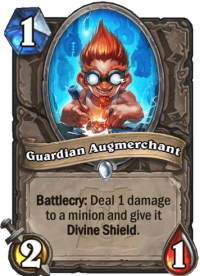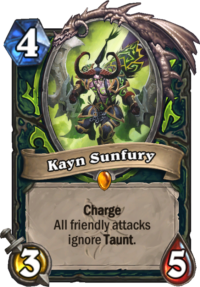Our Aggro Demon Hunter deck list guide for the Madness at the Darkmoon Faire expansion features one of the top lists for this archetype. This Demon Hunter guide includes Mulligan Strategy, Gameplay Tips, Card Substitutions, and Combos/Synergies!
Introduction
Aggro Demon Hunter is one of the early pacesetters of the Madness at the Darkmoon Faire meta, leaning into the class’ consistent aggressive gameplan but with a much lower curve than ever before thanks to great synergistic redraw tools in the form of Acrobatics and Stiltstepper alongside Voracious Reader from Scholomance Academy. This ensures an ultra-fast burn-based approach that is faster than any previous Demon Hunter builds, even the meta-dominating tempo decks from the Ashes of Outland era. Turns out there is no need for a curve-topper like a pre-nerf Priestess of Fury or a Warglaives of Azzinoth when you can consistently refill your hand with cheap minions and direct damage cards in an aggressive deck like this.
Aggro Demon Hunter Deck List
We’ve featured WuLing’s #33 Legend list but the Card Replacements section of the guide will go into detail on other high-ranked builds of the archetype too!
Find more versions of this deck type on our Aggro Demon Hunter archetype page!
Mulligan Guide and Strategy
Higher Priority (Keep every time)
- Battlefiend and Blazing Battlemage – These are your premium one mana minions which you always want to start the game out with. Everything else depends on the context of your hand and the opponent you’re facing.
Lower Priority (Keep only if certain conditions are met)
- Intrepid Initiate – Keep going second so you can guarantee the Spellburst trigger or if you don’t have any other playable one-drop in hand.
- Demon Companion – Keep if you don’t have any of the above.
- Mana Burn – Keep if you have a strong curve otherwise and you know you can disrupt a key turn two play early on.
- Beaming Sidekick and Guardian Augmerchant – Keep alongside a strong one-drop on the coin or with two other one-drops going second.
- Wriggling Horror – Keep against slow decks going second with two other one-drops in hand as you can basically guarantee it hitting the board for full value.
- Bonechewer Brawler – Keep going first with a premium one-drop, toss otherwise.
- Dreadlord's Bite – Keep in aggro mirrors if you have a good one-drop and if you can ensure the Outcast trigger on turn three based on your hand composition.
General Playstyle and Strategy
Vs Aggro

Don’t worry about the roles this time around: you will always be the beatdown with this deck – okay, with the exception of going second in the mirror match. Though you do want to focus on removing certain key minions that can get out of hand if left unchecked – Dwarven Sharpshooter, Surging Tempest and Paladins’ early buff targets come to mind – you will inevitably have more consistent early turns and a lower curve than your opponents, which means they are favored in the long game. Guardian Augmerchant and Beaming Sidekick are your best tools when it comes to securing that crucial early board lead alongside Wriggling Horror.
Overall, your playstyle in these matchups will be very similar to how you approach the games against control decks, which should make it fairly simple to figure out the basic approach of Aggro Demon Hunter. The main thing to keep in mind is that this is a bona fide face deck, not one focused around tempo: your minions are too small and fragile to be worth supporting with clears, and therefore almost every point of damage output should end up going to the dome for best results.
Vs Control
This is one of the fastest aggro decks in recent years and you should play it accordingly. Your consistent redraws will ensure that you can always count on a hefty amount of burn damage over the course of a game, meaning you should not waste any damage on trades that can also be sent upstairs. If your minions got to hit face once, their mission is basically complete. The two copies of Twin Slice and Stiltstepper amount to sixteen damage by themselves in a long match, meaning you should let your opponent worry about securing the board: any repetitive minion damage is just a bonus.
The best way to find a few extra percentage points in these matchups is to pay careful attention to your mana usage, ensuring you float as little as possible in the early turns and maximize the amount of stats on the board in the opening rounds of the game when the slower opponents are still struggling to respond to your development. By turn six, you will be guaranteed to be able to play your draw from Stiltstepper and get the bonus four damage from it – if you’re really hurting for card draw, the risk can be worth taking on turn five too. Similarly, you want to hold back Acrobatics as long as possible and prioritize almost any other card in your hand before casting it so that you can get all four cards. Your overall goal is to close out the game as quickly as possible off the back of early minion presence, and if that fails, you need to maximize your redraws and your consequent damage output.
Card Replacements

The ultra-aggressive nature of this deck means that certain cards that were previously considered no-brainer staples are too slow or irrelevant. You probably noticed how the featured list omitted Umberwing but it is a perfectly serviceable alternative to Crimson Sigil Runner if you’d like to shore up your anti-aggro matchups a bit. Viper’s #56 Legend build features two copies of Cult Neophyte, one Relentless Pursuit and Kayn Sunfury in place of Intrepid Initiate and Bonechewer Brawler, which is a good way to find a few extra percentages against slower opposition.
Since every player has access to the Demon Hunter Initiate set, this is one of the cheapest meta decks to put together – even the aforementioned build with the added Legendary ends up at 3840 dust. The other two are only 2160, offering a great budget option for newcomers and free-to-play players on the current ladder environment. Check out the side-by-side comparison of the three decks here!
Leave a Reply
You must be logged in to post a comment.













Hey dude, I always enjoy reading your guides especially given our similar love for “vengeance” since AoO. I knew my mulligans without the guide, however, I was puzzled by a sentence:
“Beaming Sidekick and Guardian Augmerchant – Keep alongside a strong one-drop on the coin or with two other one-drops going second.”
Is there something I don’t get? Do you mean going first? Or keep with two other one-drops going second if these 2 one-drops are not the premium ones?
Keep up the good work 🙂